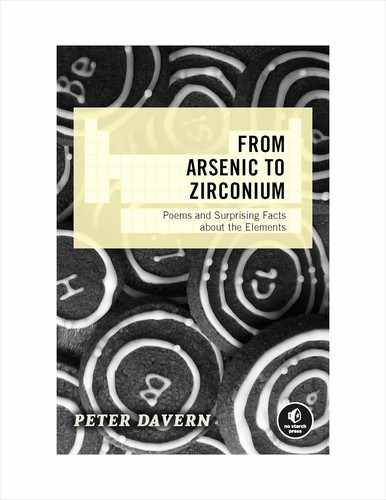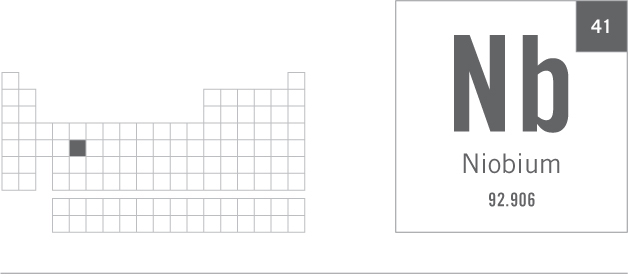NIOBIUM, Nb
CHILD OF TANTALUS
enn-bees
Niobe, child of Tantalus, inspired soft Nb’s name,
GROUP 5 TRANSITION METAL
Niobium is a soft, grayish transition metal chemically similar to tantalum (see “Tantalum, Ta” on page 211). The two elements are found together in nature and difficult to separate. Niobium was named after Niobe, goddess of grief in Greek mythology and daughter of King Tantalus (after whom tantalum was named).
emm-arr-eyes
Conducts so well (when paired with tin) ’round MRI’s coil’d frame.
Wires made from niobium’s alloy with tin become superconducting when cooled below –250°C. Magnetic resonance imaging (MRI) scanners use these wires arranged in coils around the machine’s patient chamber. During the scanning process, the wires are cooled with liquid helium. This helps generate the strong magnetic fields needed to produce the detailed diagnostic images of the patient’s organs and body structure.
Helps steel to withstand rust ’n’ heat,
In rocket nozzles, hard to beat.
Niobium improves steel’s heat-resistant and rust-proof properties when added in small amounts. If added in larger amounts, it increases the steel alloy’s heat-resistance to a level suitable for use in rocket nozzles.
Its oxide layer, once anodized, sports hues to much acclaim.
[sport: verb — to wear or display]
Visible light (light detectable by the human eye) travels in waves. Visible light is composed of a rainbow spectrum of colors; each color is characterized by a wave with a specific length, which is called a wavelength. An electrochemical process can be used to create an attractively colored niobium surface by influencing which wavelengths of visible light reflect from the surface. Niobium is protected by a thin surface layer of oxide that is usually transparent to visible light. So when light hits a sample of the metal, all the wavelengths in its rainbow spectrum reflect from the surface of the oxide layer and also from the underlying metal surface. But when the oxide layer is sufficiently thick, some reflected light waves emerge from the two surfaces such that they are out of phase with each other: their wavelengths either partially or fully cancel each other out. This results in wavelength gaps within the reflected light’s rainbow spectrum. The gaps cause the metal surface to display a range of colors: the specific colors depend on the thickness of the layer and the angle at which you view the reflected light.
The thickness of niobium’s oxide layer can be enhanced in a controlled manner. This is done by connecting a sample of the metal to the anode of an electrolytic cell and then varying the magnitude of the current and the time the current flows through the cell. This anodizing process creates metallic jewelry in a variety of attractive colors, most notably purples and blues.

